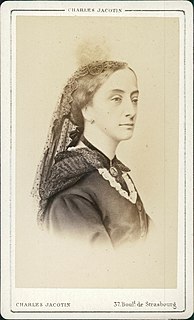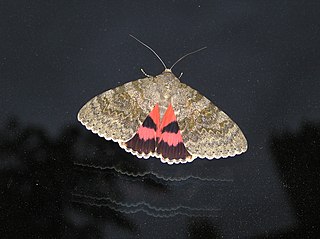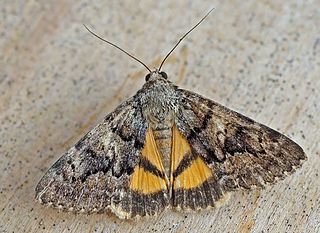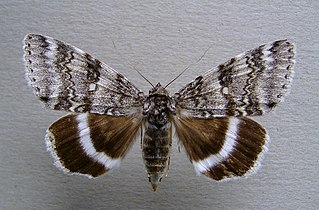
The red underwing is a moth of the family Erebidae. The species was first described by Carl Linnaeus in his 1767 12th edition of Systema Naturae.

Dona Francisca was a princess of the Empire of Brazil, who became Princess of Joinville upon marrying François d’Orléans, son of the French king Louis Philippe I. The couple had three children. Through their oldest daughter, Francisca and François are the ancestors of Jean, Count of Paris, the present Orléanist pretender to the French throne.

Catocala is a generally Holarctic genus of moths in the family Erebidae. The genus was erected by Franz von Paula Schrank in 1802. The moths are commonly known as underwing moths or simply underwings. These terms are sometimes used for a few related moths, but usually – especially when used in plural, not as part of a species name – they are used to refer to Catocala only.

Elisa Di Francisca is an Italian foil fencer, Olympic champion in 2012, World champion in 2010 and three-time European champion. She won the 2010–11 World Cup series and has seven World Cup victories to her name. With the Italian team, she was Olympic champion in 2012, five-time World champion and seven-time European champion.

Catocala elocata, the French red underwing, is a moth of the family Erebidae. It is found in Central Europe, Southern Europe, North Africa, Anatolia, Uzbekistan, and Kazakhstan.

Catocala fraxini, the blue underwing or Clifden nonpareil, is a moth of the family Erebidae. The species was first described by Carl Linnaeus in his 1758 10th edition of Systema Naturae.

Catocala fulminea, the yellow bands underwing, is a moth of the family Erebidae. The species was first described by Giovanni Antonio Scopoli in his 1763 Entomologia Carniolica. It is found in central and southern Europe, east Asia and Siberia. The xarippe lineage has been proposed to be a distinct and valid species in its own right, instead of being only subspecifically distinct.

Catocala electa, the rosy underwing, is a moth of the family Erebidae. The species was first described by Karl Friedrich Vieweg in 1790. It can be found in Europe and Asia.

Catocala promissa, the light crimson underwing, is a moth of the family Erebidae. The species was first described by Michael Denis and Ignaz Schiffermüller in 1775. It can be found in Europe and Anatolia up to Armenia.

Catocala nymphaea is a species of moth of the family Erebidae. It was described by Eugenius Johann Christoph Esper in 1787. It is found in southern France, Austria, Albania, Portugal, Italy, Greece, Corsica, Sicily, Crete, North Africa, Anatolia, Afghanistan and Kashmir.

Catocala meskei, or Meske's underwing, is a moth of the family Erebidae. The species was first described by Augustus Radcliffe Grote in 1873. It is found in North America from Maine and Quebec west to southern Alberta and Montana, south to South Carolina in the east and at least Montana in the west.

Catocala hermia, the Hermia underwing, is a moth of the family Erebidae. The species was first described by Henry Edwards in 1880. It is found throughout the Great Plains of North America, from southern Saskatchewan and Alberta south and west to Texas, Arizona and California.

Catocala junctura, the joined underwing or Stretch's underwing, is an moth in the family Erebidae. The species was first described by Francis Walker in 1858. It is found throughout temperate North America ranging from New York and Pennsylvania west to Montana, Colorado, Oklahoma, Arizona and into Texas, and north to southern Illinois, extreme southern Alberta and Saskatchewan; it has also been recorded west of the Rocky Mountains from California and south-eastern British Columbia. It is typically found near water, where the food plants of its caterpillar larvae grow plentifully.

Catocala relicta, the white underwing or relict, is a moth of the family Erebidae. The species was first described by Francis Walker in 1858. It is found in southern Canada, from Newfoundland to Vancouver Island, south to Missouri, and Arizona.

Catocala semirelicta, the semirelict underwing, is a moth of the family Erebidae. The species was first described by Augustus Radcliffe Grote in 1874. It is found in North America from Nevada, Colorado, Utah, California, and Nova Scotia south to Maine, west across Canada to British Columbia, and southward in the mountains.

Catocala puerpera is a moth of the family Erebidae first described by Michel-Esprit Giorna in 1791. It is found in Mediterranean and sub-Mediterranean areas of the Near East and Middle East and in North Africa.

Catocala pretiosa, the precious underwing, is a moth of the family Erebidae. The species was first described by Joseph Albert Lintner in 1876. It was included in Catocala crataegi by many authors, but recently it has been revalidated as a distinct species. The subspecies of pretiosa is listed as a species of special concern and believed extirpated in the US state of Connecticut.
Francisca is a throwing axe used as a weapon during the Early Middle Ages by the Franks.
Francisca Luhong James also known as Francisca Luhong, is a Malaysian model and beauty pageant titleholder who was crowned Miss Universe Malaysia 2020.
















